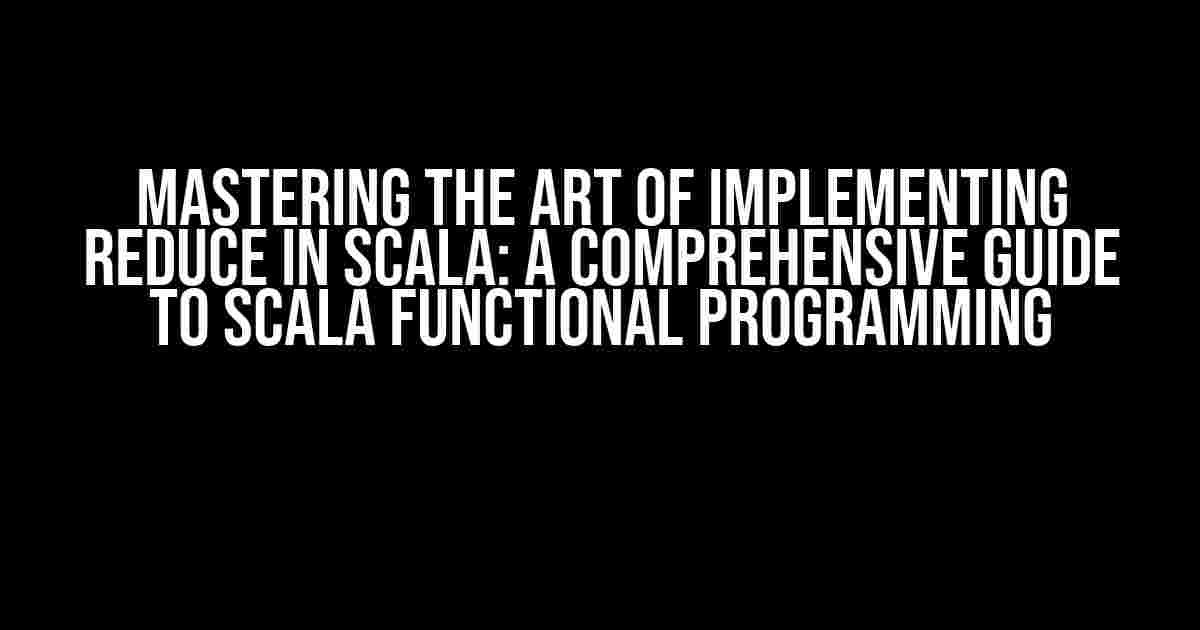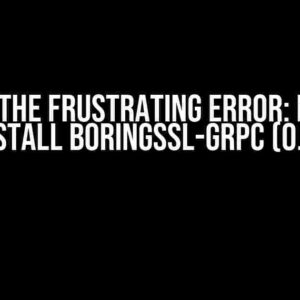Scala, a hybrid programming language that combines the best of object-oriented and functional programming, offers a plethora of features that make it an attractive choice for developers. One of the most pivotal concepts in Scala functional programming is the reduce function. In this article, we’ll delve into the world of implementing reduce in Scala, exploring its syntax, examples, and best practices.
What is the Reduce Function?
The reduce function, a higher-order function, is a crucial element in functional programming. It takes a collection of elements and applies a binary operation to reduce the collection to a single value. In other words, reduce collapses a sequence of values into a single output.
Syntax and Basic Example
scala> val numbers = List(1, 2, 3, 4, 5)
numbers: List[Int] = List(1, 2, 3, 4, 5)
scala> val sum = numbers.reduce((a, b) => a + b)
sum: Int = 15
In the above example, we define a list of integers and use the reduce function to calculate the sum of all elements in the list. The lambda function `(a, b) => a + b` takes two arguments, `a` and `b`, and returns their sum.
Understanding the Reduce Function
The reduce function operates on a collection of elements, applying a binary operation to reduce the collection to a single value. The operation is applied in a specific order, typically from left to right.
Associativity and Commutativity
For the reduce function to work correctly, the binary operation must be both associative and commutative.
- Associativity: The order in which the operation is applied does not affect the result. For example, `(a + b) + c` is equal to `a + (b + c)`.
- Commutativity: The order of the operands does not affect the result. For example, `a + b` is equal to `b + a`.
In the case of the sum example above, the addition operation is both associative and commutative, making it an ideal candidate for the reduce function.
Implementing Reduce in Scala
Now that we’ve covered the basics of the reduce function, let’s dive into implementing it in Scala.
Using the `reduce` Method
scala> val numbers = List(1, 2, 3, 4, 5)
numbers: List[Int] = List(1, 2, 3, 4, 5)
scala> val sum = numbers.reduce(_ + _)
sum: Int = 15
In this example, we use the `reduce` method on the `List` collection, passing a lambda function `_ + _` as the binary operation. The `_` placeholder represents the operand, and the `+` operator is the binary operation.
Using the `foldLeft` Method
scala> val numbers = List(1, 2, 3, 4, 5)
numbers: List[Int] = List(1, 2, 3, 4, 5)
scala> val sum = numbers.foldLeft(0)((a, b) => a + b)
sum: Int = 15
The `foldLeft` method is another way to implement the reduce function in Scala. It takes an initial value (in this case, 0) and applies the binary operation to each element in the collection, starting from the left.
Best Practices and Gotchas
When implementing the reduce function in Scala, keep the following best practices and gotchas in mind:
- Avoid using reduce on an empty collection: Attempting to reduce an empty collection will result in a `UnsupportedOperationException`. Always ensure the collection is non-empty before calling reduce.
- Use reduce with caution on infinite sequences: Reduce can cause infinite loops if applied to infinite sequences. Be cautious when working with infinite sequences and consider using alternative methods, such as `take` or `limit`, to truncate the sequence.
- Optimize performance with parallel collections: For large collections, consider using parallel collections to take advantage of multi-core processors and improve performance.
Real-World Examples and Applications
The reduce function has numerous real-world applications in data processing, machine learning, and more. Here are a few examples:
Data Aggregation
scala> val salesData = List(Sale(10), Sale(20), Sale(30), Sale(40), Sale(50))
salesData: List[Sale] = List(Sale(10), Sale(20), Sale(30), Sale(40), Sale(50))
scala> val totalSales = salesData.map(_.amount).reduce(_ + _)
totalSales: Int = 150
In this example, we use the reduce function to calculate the total sales amount from a list of `Sale` objects.
Machine Learning
scala> val vectors = List(Vector(1, 2, 3), Vector(4, 5, 6), Vector(7, 8, 9))
vectors: List[Vector[Int]] = List(Vector(1, 2, 3), Vector(4, 5, 6), Vector(7, 8, 9))
scala> val sumVector = vectors.reduce((a, b) => a.zip(b).map(t => t._1 + t._2))
sumVector: Vector[Int] = Vector(12, 15, 18)
In this example, we use the reduce function to calculate the element-wise sum of a list of vectors.
Conclusion
In conclusion, the reduce function is a powerful tool in Scala functional programming, enabling the efficient processing of large datasets. By following the best practices and examples outlined in this article, you’ll be well-equipped to master the art of implementing reduce in Scala. Remember to keep the syntax, associativity, and commutativity of the binary operation in mind, and don’t hesitate to explore the numerous applications of reduce in data processing, machine learning, and beyond.
| Function | Description |
|---|---|
| reduce | Applies a binary operation to all elements in a collection, reducing it to a single value. |
| foldLeft | Applies a binary operation to all elements in a collection, starting from an initial value and moving left to right. |
By mastering the reduce function, you’ll unlock the full potential of Scala functional programming, empowering you to tackle complex data processing tasks with ease and efficiency.
Here are 5 Questions and Answers about “Implementing reduce in Scala (Scala FP)” :
Frequently Asked Question
Get ready to uncover the secrets of implementing reduce in Scala, a fundamental concept in functional programming!
What is the purpose of the reduce function in Scala?
The reduce function in Scala is used to aggregate elements of a collection, such as a List or Array, into a single output by applying a binary operation repeatedly. It’s like folding a piece of paper into a neat little square, but with data!
How does the reduceLeft function differ from the reduceRight function in Scala?
The reduceLeft function applies the operation from left to right, whereas reduceRight applies it from right to left. It’s like reading a book: do you start from the first page (left) or the last page (right)? Both are valid, but the approach changes the result!
Can I use reduce on an empty collection in Scala?
No, you can’t! The reduce function will throw a UnsupportedOperationException if the collection is empty. It’s like trying to build a tower with no blocks: it just won’t stand!
How do I implement a custom reduce function in Scala for a specific use case?
You can implement a custom reduce function by creating a recursive function that takes an initial value and applies the desired operation to each element in the collection. Think of it like building a custom Lego castle: you need to design the blueprint and then assemble the pieces!
What are some common use cases for the reduce function in Scala?
Common use cases for reduce include calculating the sum or product of a collection, finding the maximum or minimum value, and grouping data by a common attribute. It’s like having a superpower: you can combine and transform data in a snap!


